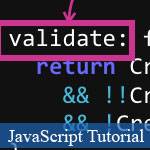









 Cet article JavaScript didacticiel vous des instructions compl?tes rempli et des exemples de code JavaScript pour utiliser cet objet JavaScript Vous pouvez apprendre beaucoup de connaissances de base JavaScript , comme la port?e , d'appeler une fonction/m?thode , etc
Cet article JavaScript didacticiel vous des instructions compl?tes rempli et des exemples de code JavaScript pour utiliser cet objet JavaScript Vous pouvez apprendre beaucoup de connaissances de base JavaScript , comme la port?e , d'appeler une fonction/m?thode , etc
Les objets JavaScript : comparer et Clone
? Permettez- Get Started JavaScript Programmation Orient?e Objet
? Quiz de test d'objets JavaScript
? Concepts simples sur les types et les objets en JavaScript POO
? Techniques Object Oriented JavaScript
JavaScript is a great programming language. That would have been a controversial statement a few years ago, but developers have rediscovered its beauty and elegance. If you dislike JavaScript, it’s probably because:
One of the most confusing concepts is the ‘this’ keyword. In most languages, ‘this’ is a reference to the current object instantiated by the class. In JavaScript, ‘this’ normally refers to the object which ‘owns’ the method, but it depends on how a function is called.
If there’s no current object, ‘this’ refers to the global object. In a web browser, that’s ‘window’ — the top-level object which represents the document, location, history and a few other useful properties and methods.
window.WhoAmI = "I'm the window object";
alert(window.WhoAmI);
alert(this.WhoAmI); // I'm the window object
alert(window === this); // true
‘this’ remains the global object if you’re calling a function:
window.WhoAmI = "I'm the window object";
function TestThis() {
alert(this.WhoAmI); // I'm the window object
alert(window === this); // true
}
TestThis();
When calling an object constructor or any of its methods, ‘this’ refers to the instance of the object — much like any class-based language:
window.WhoAmI = "I'm the window object";
function Test() {
this.WhoAmI = "I'm the Test object";
this.Check1 = function() {
alert(this.WhoAmI); // I'm the Test object
};
}
Test.prototype.Check2 = function() {
alert(this.WhoAmI); // I'm the Test object
};
var t = new Test();
t.Check1();
t.Check2();
In essence, call and apply run JavaScript functions as if they were methods of another object. A simple example demonstrates it further:
function SetType(type) {
this.WhoAmI = "I'm the "+type+" object";
}
var newObject = {};
SetType.call(newObject, "newObject");
alert(newObject.WhoAmI); // I'm the newObject object
var new2 = {};
SetType.apply(new2, ["new2"]);
alert(new2.WhoAmI); // I'm the new2 object
The only difference is that ‘call’ expects a discrete number of parameters while ‘apply’ can be passed an array of parameters.
That’s ‘this’ in a nutshell! However, there are several gotchas which may catch you out. We’ll discuss those in my next chapter
In above chapter, we looked at JavaScript’s this statement and how it can change depending on the context of the function call. Today, we’ll examine several situations where this could catch you out…
Consider the following code:
window.WhoAmI = "I'm the window object";
function Test() {
this.WhoAmI = "I'm the Test object";
}
var t = Test();
alert(window.WhoAmI); // I'm the Test object
alert(t.WhoAmI); // t is undefined
What we really meant is:
var t = new Test();
The omission of the new statement gave us
undesirable results. Other languages would throw an error when faced
with a direct call to a constructor but JavaScript simply treats it like
any other function call. this is taken to be the global window object and no value is returned from Test() so t becomes undefined.
This situation can be fixed if you’re writing a JavaScript library for third-party developers. Refer to Fixing Object Instances in JavaScript.